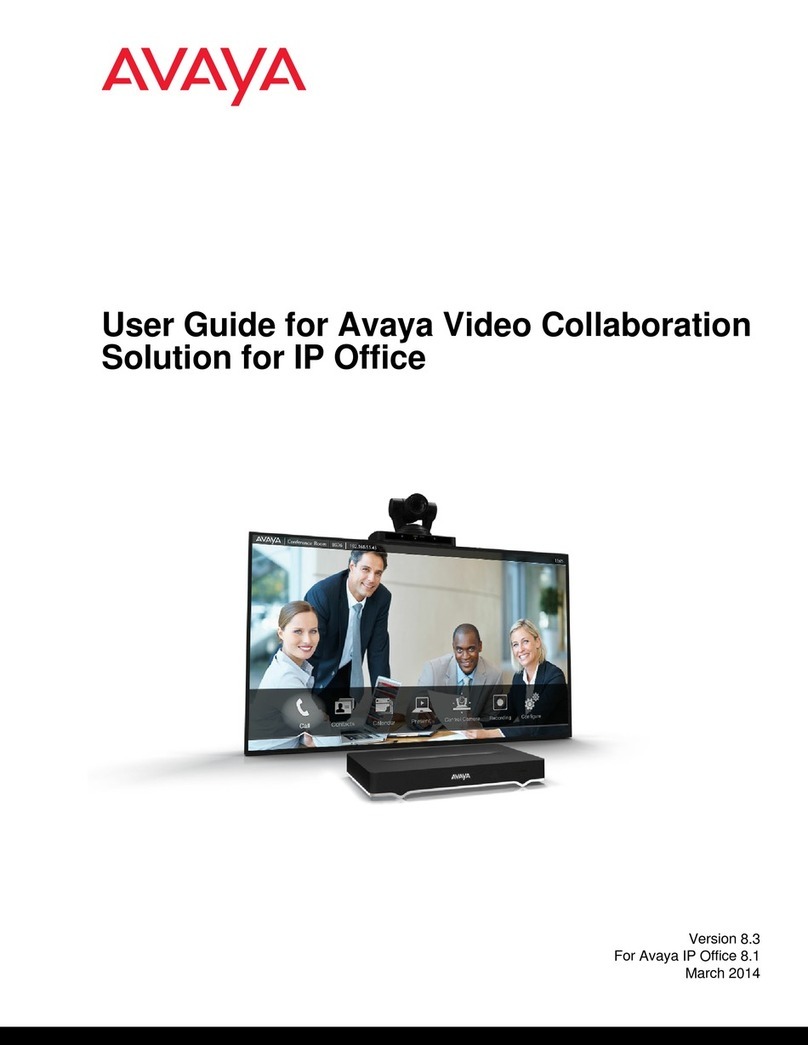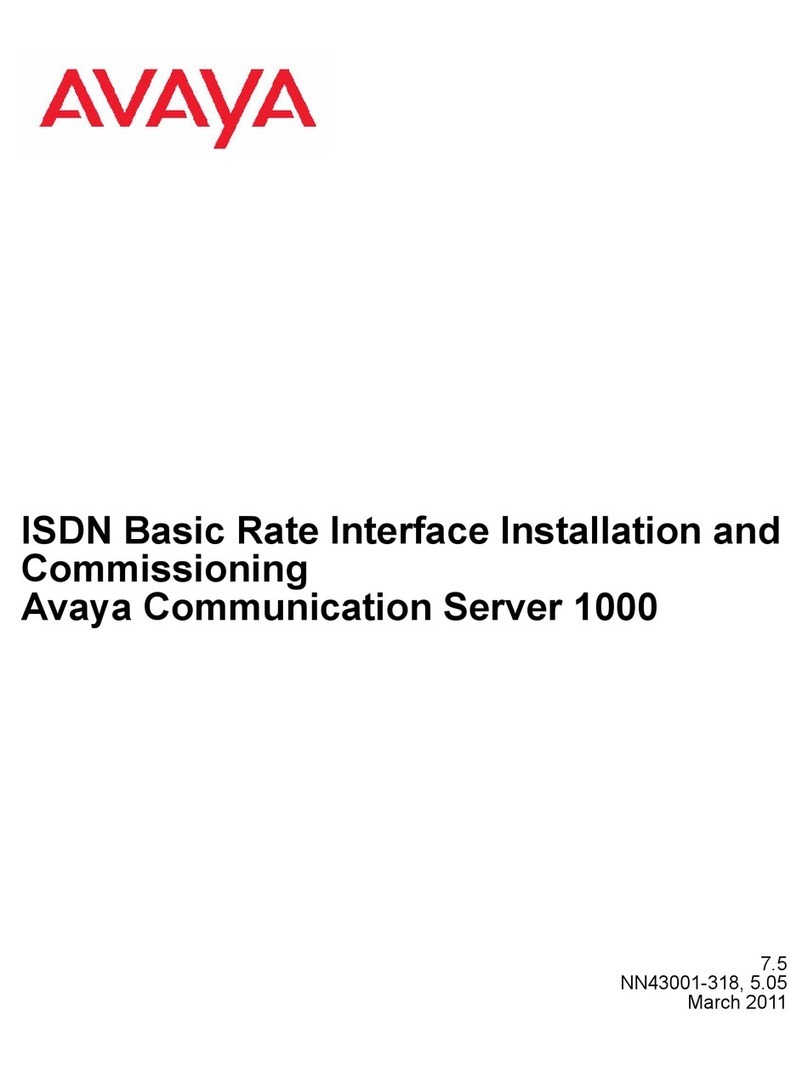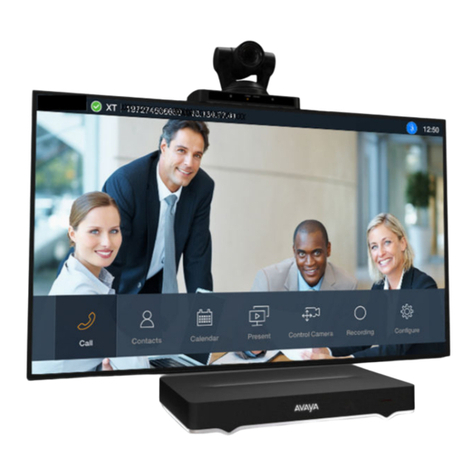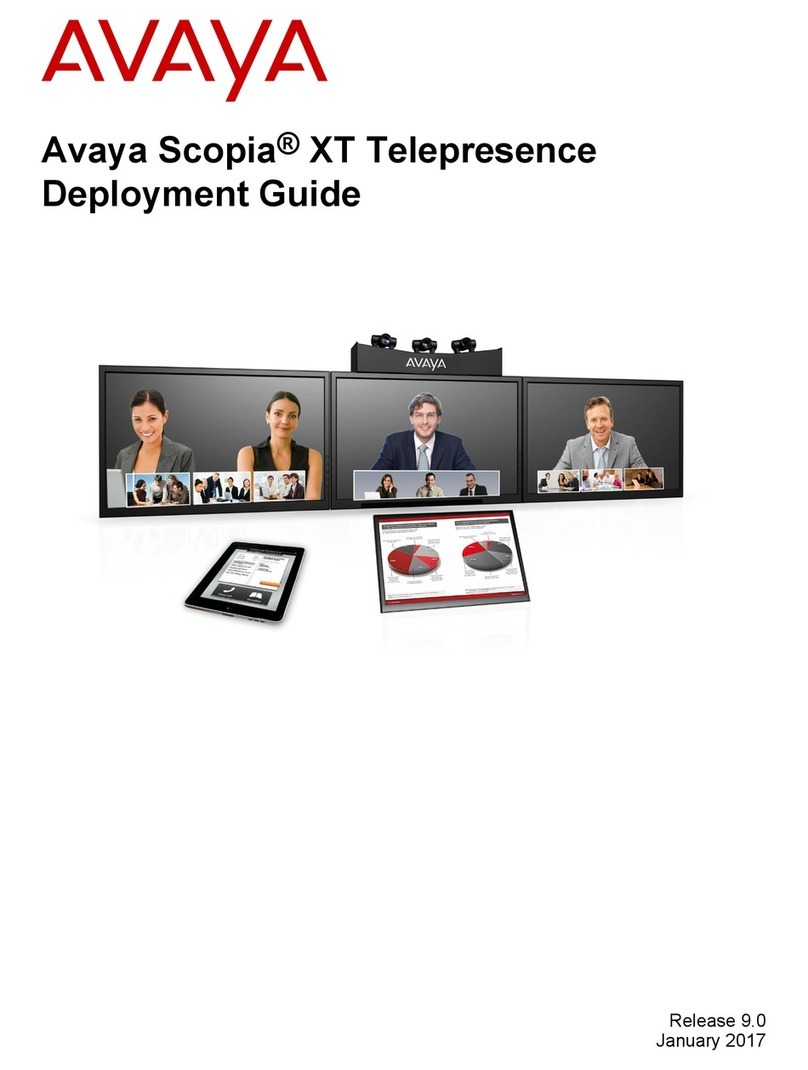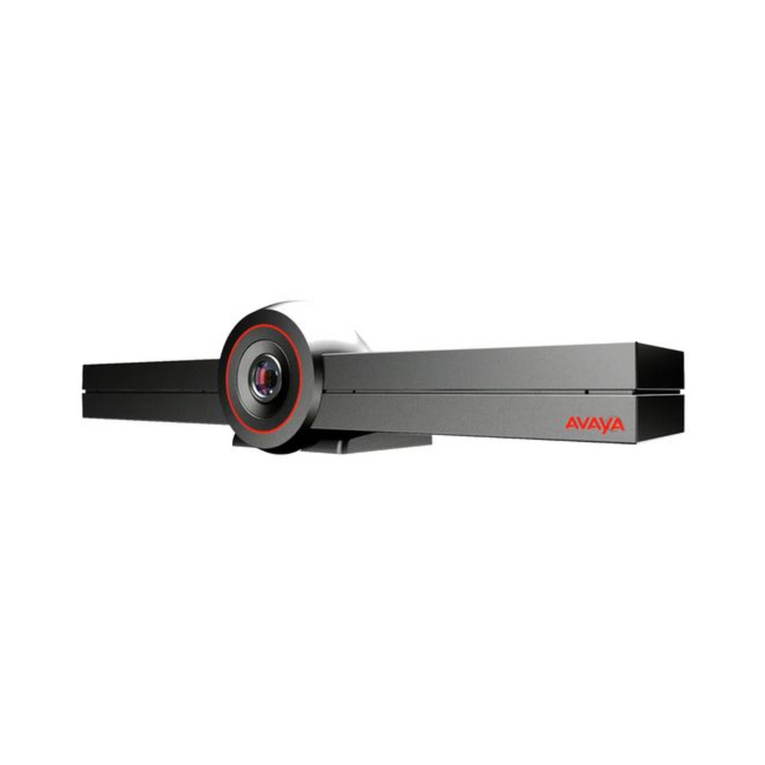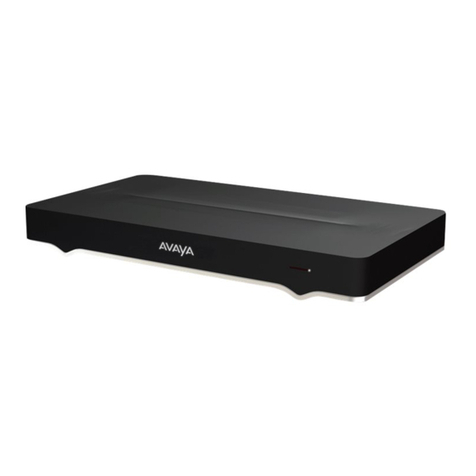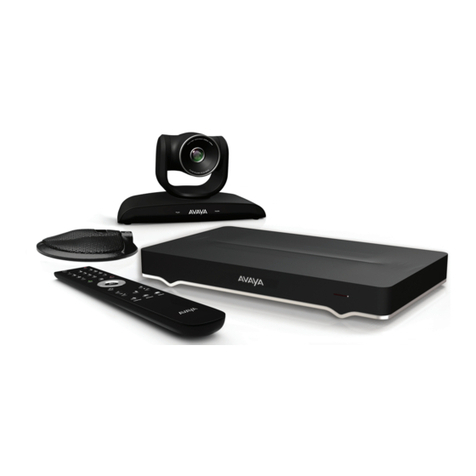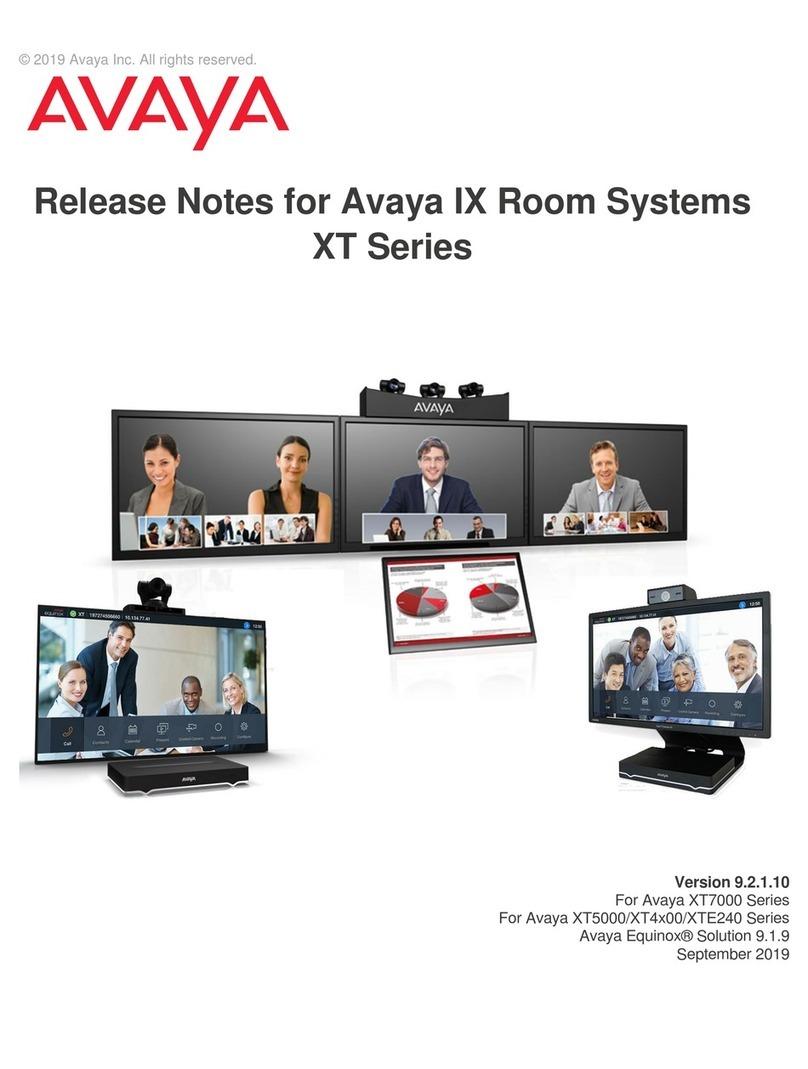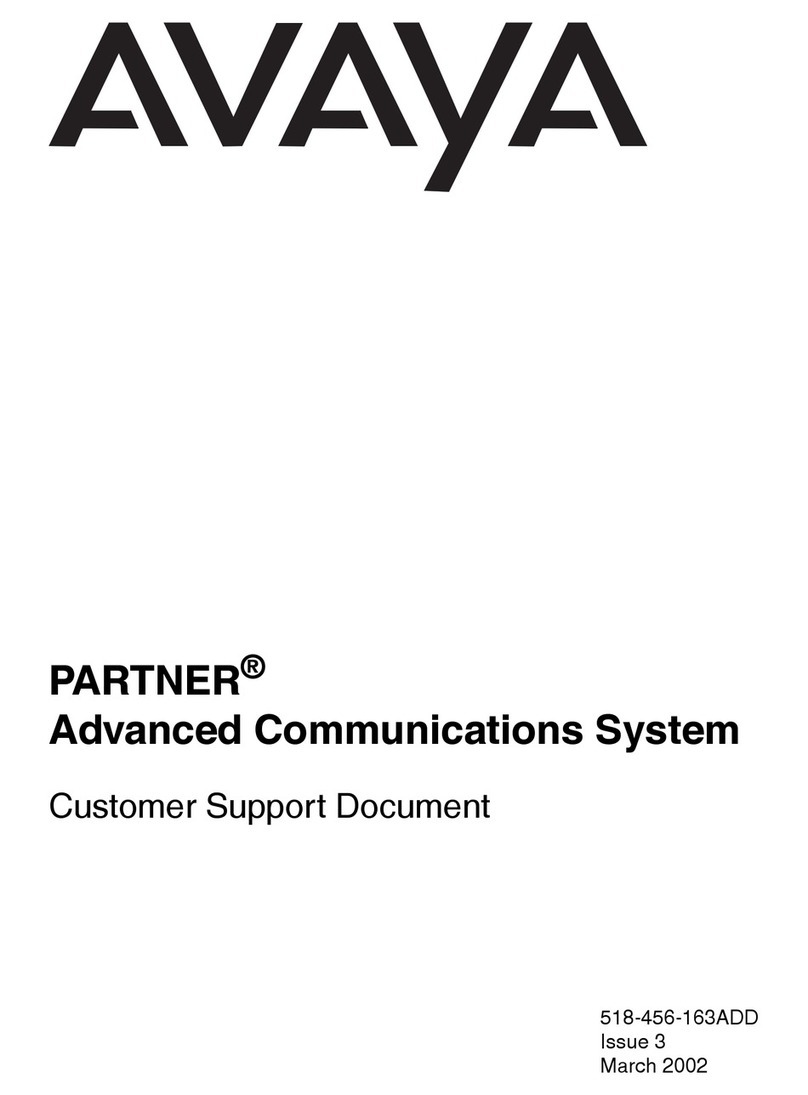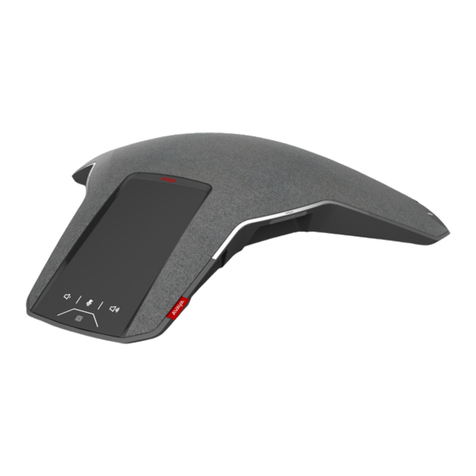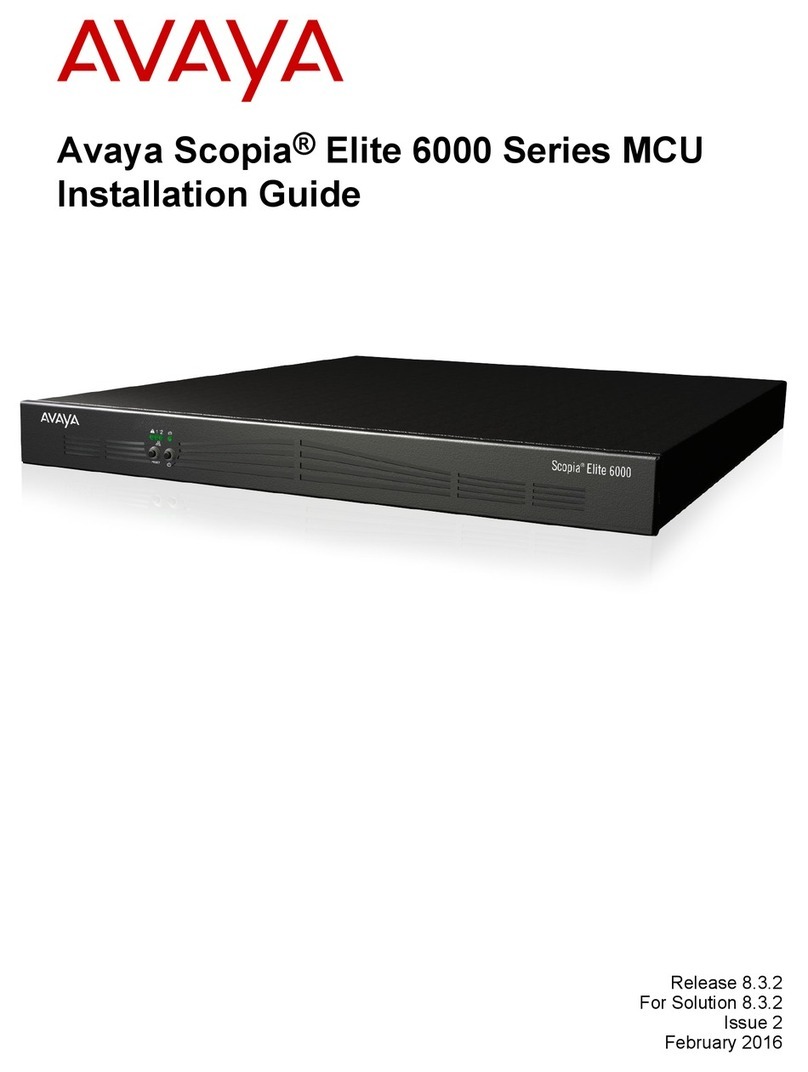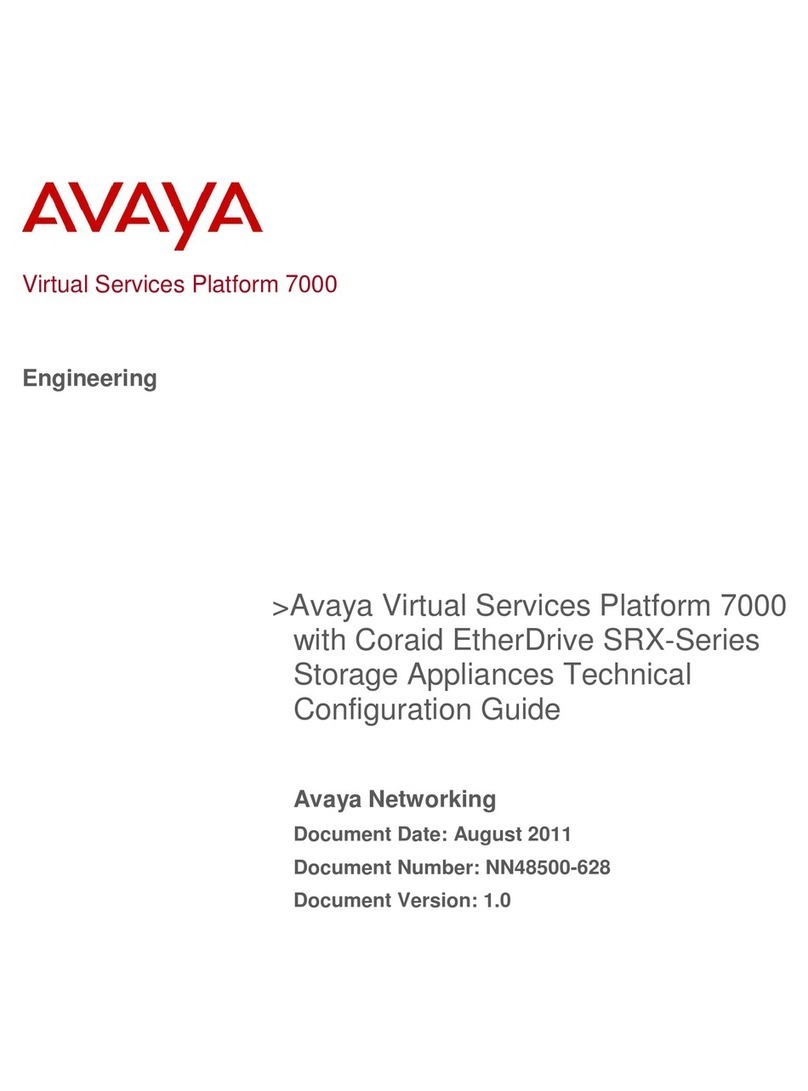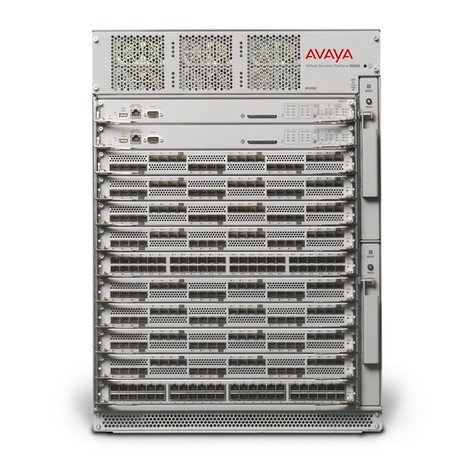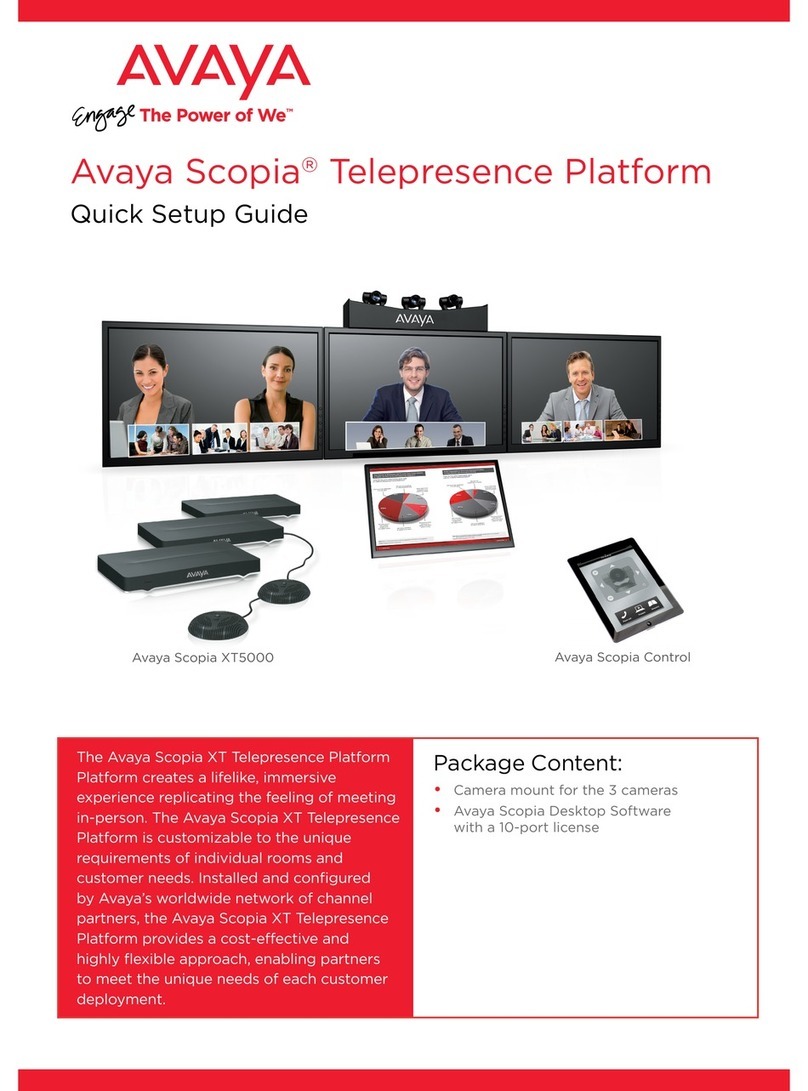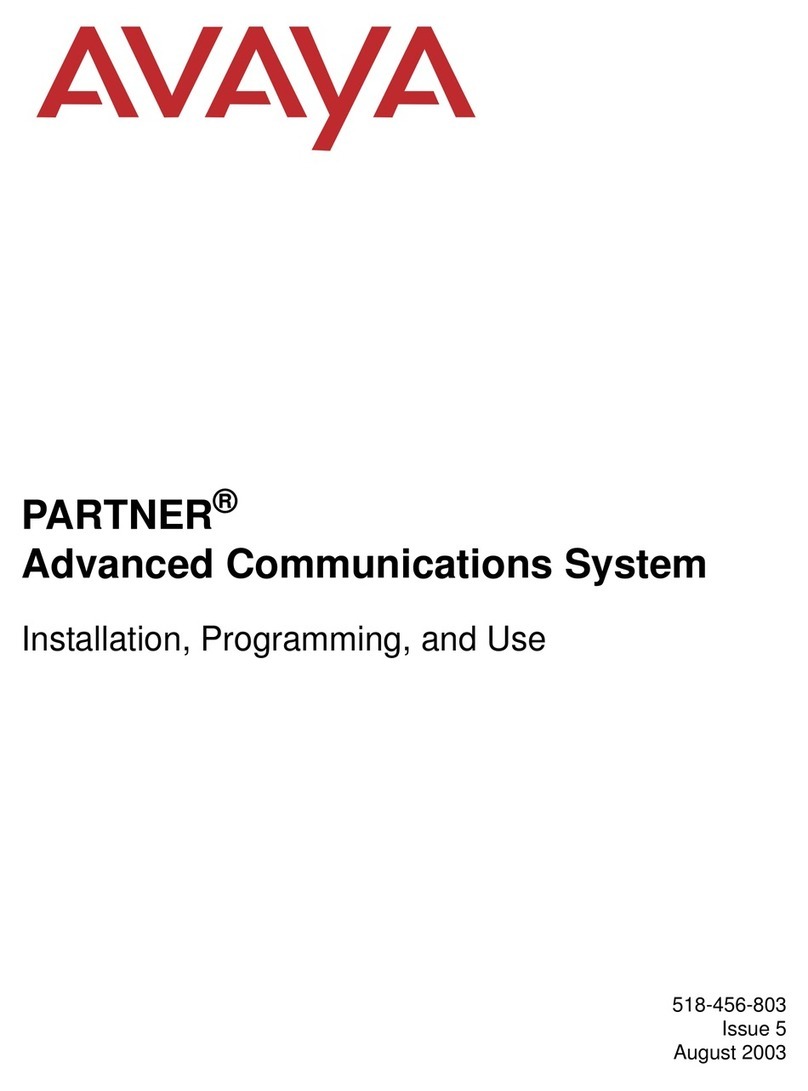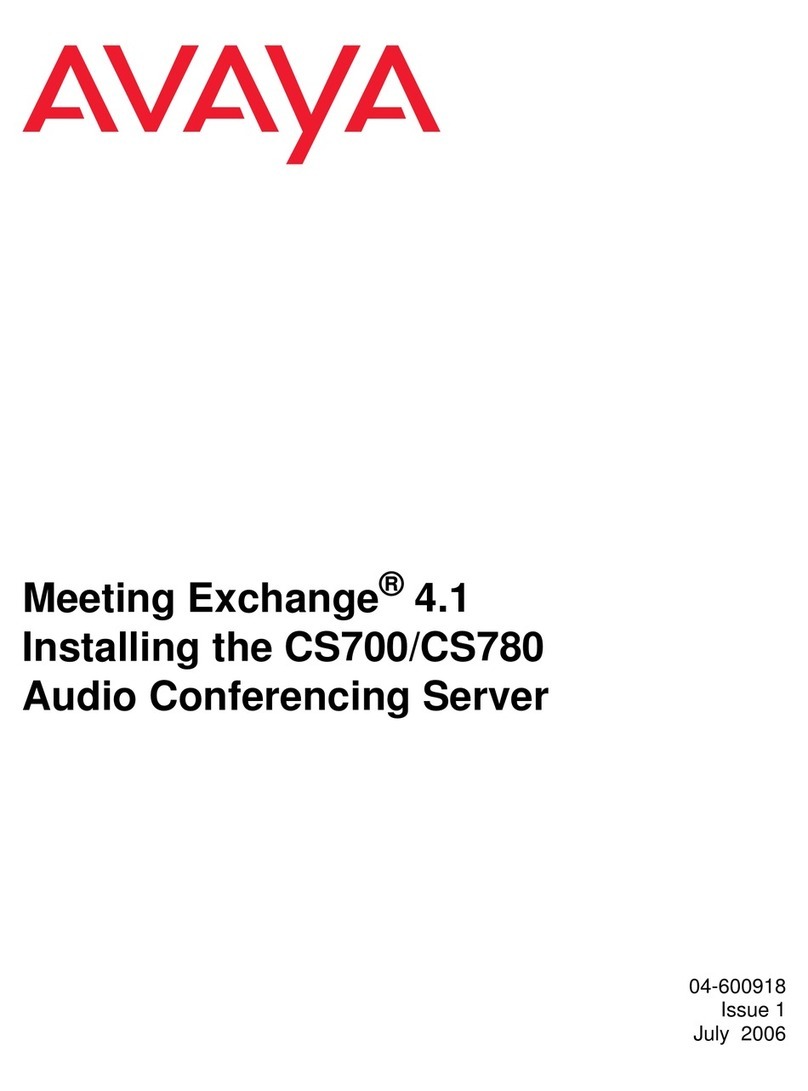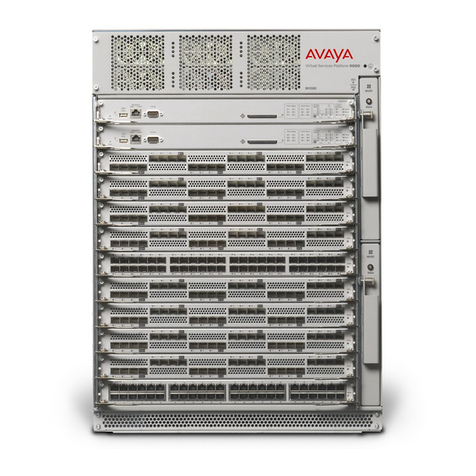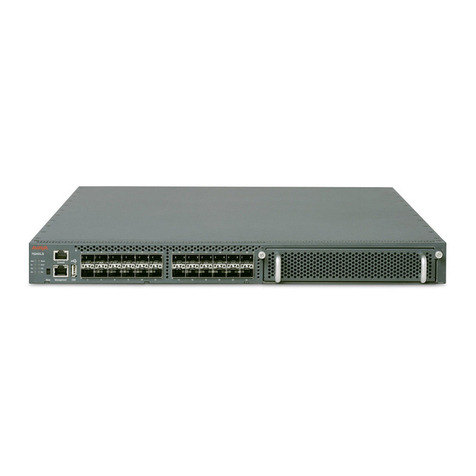
© 2014-2016, Avaya, Inc.1
All Rights Reserved.2
Notice3
While reasonable efforts have been made to ensure that the4
information in this document is complete and accurate at the time of5
printing, Avaya assumes no liability for any errors. Avaya reserves6
the right to make changes and corrections to the information in this7
document without the obligation to notify any person or organization8
of such changes.9
Documentation disclaimer10
“Documentation” means information published by Avaya in varying11
mediums which may include product information, operating12
instructions and performance specifications that Avaya may generally13
make available to users of its products and Hosted Services.14
Documentation does not include marketing materials. Avaya shall not15
be responsible for any modifications, additions, or deletions to the16
original published version of documentation unless such17
modifications, additions, or deletions were performed by Avaya. End18
User agrees to indemnify and hold harmless Avaya, Avaya's agents,19
servants and employees against all claims, lawsuits, demands and20
judgments arising out of, or in connection with, subsequent21
modifications, additions or deletions to this documentation, to the22
extent made by End User.23
Link disclaimer24
Avaya is not responsible for the contents or reliability of any linked25
websites referenced within this site or documentation provided by26
Avaya. Avaya is not responsible for the accuracy of any information,27
statement or content provided on these sites and does not28
necessarily endorse the products, services, or information described29
or offered within them. Avaya does not guarantee that these links will30
work all the time and has no control over the availability of the linked31
pages.32
Warranty33
Avaya provides a limited warranty on Avaya hardware and software.34
Refer to your sales agreement to establish the terms of the limited35
warranty. In addition, Avaya’s standard warranty language, as well as36
information regarding support for this product while under warranty is37
available to Avaya customers and other parties through the Avaya38
Support website: https://support.avaya.com/helpcenter/39
getGenericDetails?detailId=C20091120112456651010 under the link40
“Warranty & Product Lifecycle” or such successor site as designated41
by Avaya. Please note that if You acquired the product(s) from an42
authorized Avaya Channel Partner outside of the United States and43
Canada, the warranty is provided to You by said Avaya Channel44
Partner and not by Avaya.45
“Hosted Service” means a hosted service subscription that You46
acquire from either Avaya or an authorized Avaya Channel Partner47
(as applicable) and which is described further in Hosted SAS or other48
service description documentation regarding the applicable hosted49
service. If You purchase a Hosted Service subscription, the foregoing50
limited warranty may not apply but You may be entitled to support51
services in connection with the Hosted Service as described further52
in your service description documents for the applicable Hosted53
Service. Contact Avaya or Avaya Channel Partner (as applicable) for54
more information.55
Hosted Service56
THE FOLLOWING APPLIES IF YOU PURCHASE A HOSTED57
SERVICE SUBSCRIPTION FROM AVAYA OR AN AVAYA58
CHANNEL PARTNER (AS APPLICABLE), THE TERMS OF USE59
FOR HOSTED SERVICES ARE AVAILABLE ON THE AVAYA60
WEBSITE, HTTPS://SUPPORT.AVAYA.COM/LICENSEINFO61
UNDER THE LINK “Avaya Terms of Use for Hosted Services” OR62
SUCH SUCCESSOR SITE AS DESIGNATED BY AVAYA, AND ARE63
APPLICABLE TO ANYONE WHO ACCESSES OR USES THE64
HOSTED SERVICE. BY ACCESSING OR USING THE HOSTED65
SERVICE, OR AUTHORIZING OTHERS TO DO SO, YOU, ON66
BEHALF OF YOURSELF AND THE ENTITY FOR WHOM YOU ARE67
DOING SO (HEREINAFTER REFERRED TO INTERCHANGEABLY68
AS “YOU” AND “END USER”), AGREE TO THE TERMS OF USE. IF69
YOU ARE ACCEPTING THE TERMS OF USE ON BEHALF A70
COMPANY OR OTHER LEGAL ENTITY, YOU REPRESENT THAT71
YOU HAVE THE AUTHORITY TO BIND SUCH ENTITY TO THESE72
TERMS OF USE. IF YOU DO NOT HAVE SUCH AUTHORITY, OR
73
IF YOU DO NOT WISH TO ACCEPT THESE TERMS OF USE, YOU74
MUST NOT ACCESS OR USE THE HOSTED SERVICE OR75
AUTHORIZE ANYONE TO ACCESS OR USE THE HOSTED76
SERVICE. YOUR USE OF THE HOSTED SERVICE SHALL BE77
LIMITED BY THE NUMBER AND TYPE OF LICENSES78
PURCHASED UNDER YOUR CONTRACT FOR THE HOSTED79
SERVICE, PROVIDED, HOWEVER, THAT FOR CERTAIN HOSTED80
SERVICES IF APPLICABLE, YOU MAY HAVE THE OPPORTUNITY81
TO USE FLEX LICENSES, WHICH WILL BE INVOICED82
ACCORDING TO ACTUAL USAGE ABOVE THE CONTRACT83
LICENSE LEVEL. CONTACT AVAYA OR AVAYA’S CHANNEL84
PARTNER FOR MORE INFORMATION ABOUT THE LICENSES85
FOR THE APPLICABLE HOSTED SERVICE, THE AVAILABILITY86
OF ANY FLEX LICENSES (IF APPLICABLE), PRICING AND87
BILLING INFORMATION, AND OTHER IMPORTANT88
INFORMATION REGARDING THE HOSTED SERVICE.89
Licenses90
THE SOFTWARE LICENSE TERMS AVAILABLE ON THE AVAYA91
WEBSITE, HTTPS://SUPPORT.AVAYA.COM/LICENSEINFO,92
UNDER THE LINK “AVAYA SOFTWARE LICENSE TERMS (Avaya93
Products)” OR SUCH SUCCESSOR SITE AS DESIGNATED BY94
AVAYA, ARE APPLICABLE TO ANYONE WHO DOWNLOADS,95
USES AND/OR INSTALLS AVAYA SOFTWARE, PURCHASED96
FROM AVAYA INC., ANY AVAYA AFFILIATE, OR AN AVAYA97
CHANNEL PARTNER (AS APPLICABLE) UNDER A COMMERCIAL98
AGREEMENT WITH AVAYA OR AN AVAYA CHANNEL PARTNER.99
UNLESS OTHERWISE AGREED TO BY AVAYA IN WRITING,100
AVAYA DOES NOT EXTEND THIS LICENSE IF THE SOFTWARE101
WAS OBTAINED FROM ANYONE OTHER THAN AVAYA, AN102
AVAYA AFFILIATE OR AN AVAYA CHANNEL PARTNER; AVAYA103
RESERVES THE RIGHT TO TAKE LEGAL ACTION AGAINST YOU104
AND ANYONE ELSE USING OR SELLING THE SOFTWARE105
WITHOUT A LICENSE. BY INSTALLING, DOWNLOADING OR106
USING THE SOFTWARE, OR AUTHORIZING OTHERS TO DO SO,107
YOU, ON BEHALF OF YOURSELF AND THE ENTITY FOR WHOM108
YOU ARE INSTALLING, DOWNLOADING OR USING THE109
SOFTWARE (HEREINAFTER REFERRED TO110
INTERCHANGEABLY AS “YOU” AND “END USER”), AGREE TO111
THESE TERMS AND CONDITIONS AND CREATE A BINDING112
CONTRACT BETWEEN YOU AND AVAYA INC. OR THE113
APPLICABLE AVAYA AFFILIATE (“AVAYA”).114
Avaya grants You a license within the scope of the license types115
described below, with the exception of Heritage Nortel Software, for116
which the scope of the license is detailed below. Where the order117
documentation does not expressly identify a license type, the118
applicable license will be a Designated System License. The119
applicable number of licenses and units of capacity for which the120
license is granted will be one (1), unless a different number of121
licenses or units of capacity is specified in the documentation or other122
materials available to You. “Software” means computer programs in123
object code, provided by Avaya or an Avaya Channel Partner,124
whether as stand-alone products, pre-installed on hardware products,125
and any upgrades, updates, patches, bug fixes, or modified versions126
thereto. “Designated Processor” means a single stand-alone127
computing device. “Server” means a Designated Processor that128
hosts a software application to be accessed by multiple users.129
“Instance” means a single copy of the Software executing at a130
particular time: (i) on one physical machine; or (ii) on one deployed131
software virtual machine (“VM”) or similar deployment.132
License type(s)133
Designated System(s) License (DS). End User may install and use134
each copy or an Instance of the Software only on a number of135
Designated Processors up to the number indicated in the order.136
Avaya may require the Designated Processor(s) to be identified in137
the order by type, serial number, feature key, Instance, location or138
other specific designation, or to be provided by End User to Avaya139
through electronic means established by Avaya specifically for this140
purpose.141
Concurrent User License (CU). End User may install and use the142
Software on multiple Designated Processors or one or more Servers,143
so long as only the licensed number of Units are accessing and using144
the Software at any given time. A “Unit” means the unit on which145
Avaya, at its sole discretion, bases the pricing of its licenses and can146
be, without limitation, an agent, port or user, an e-mail or voice mail147
